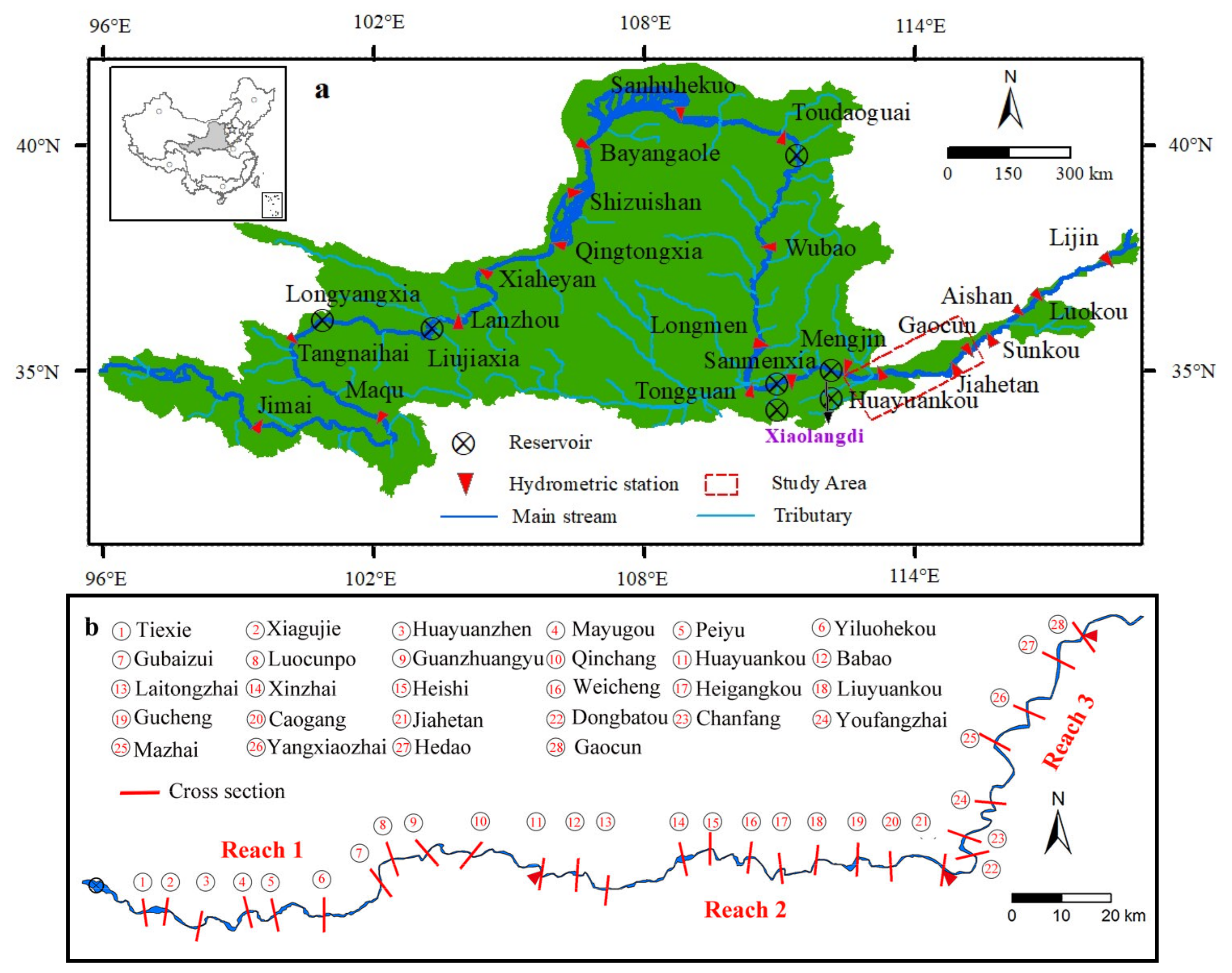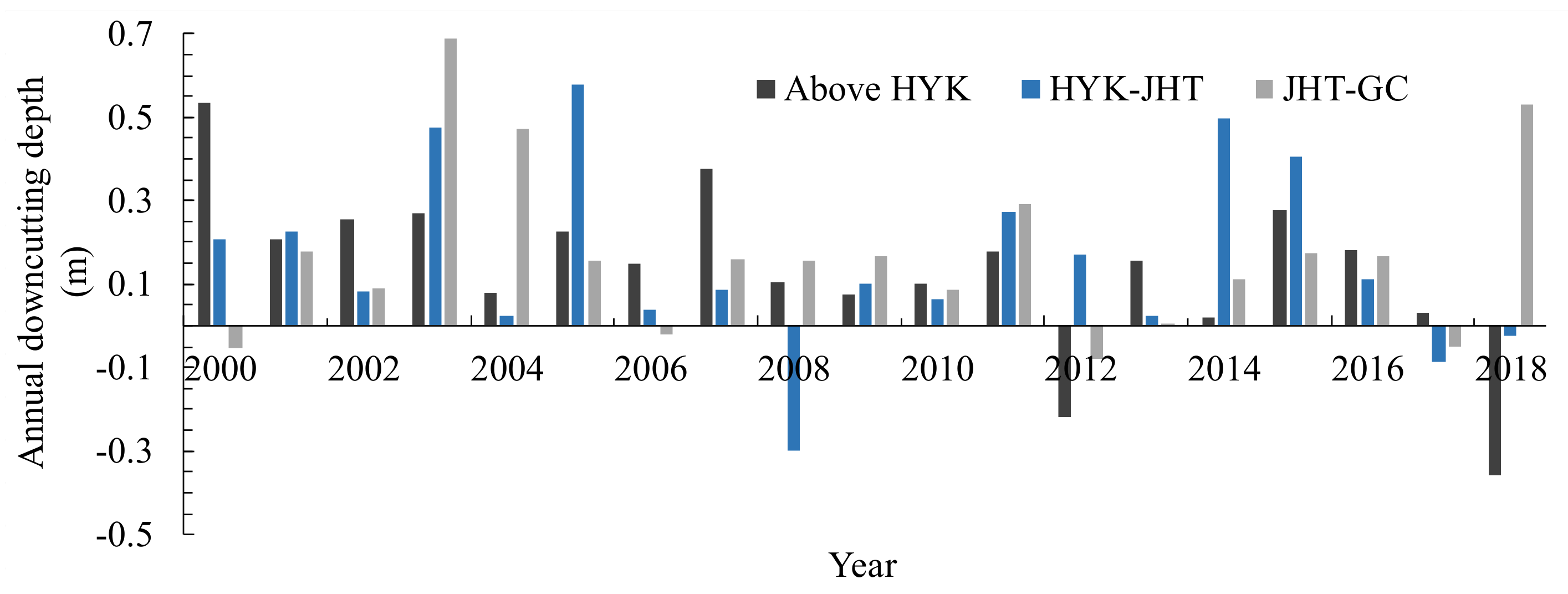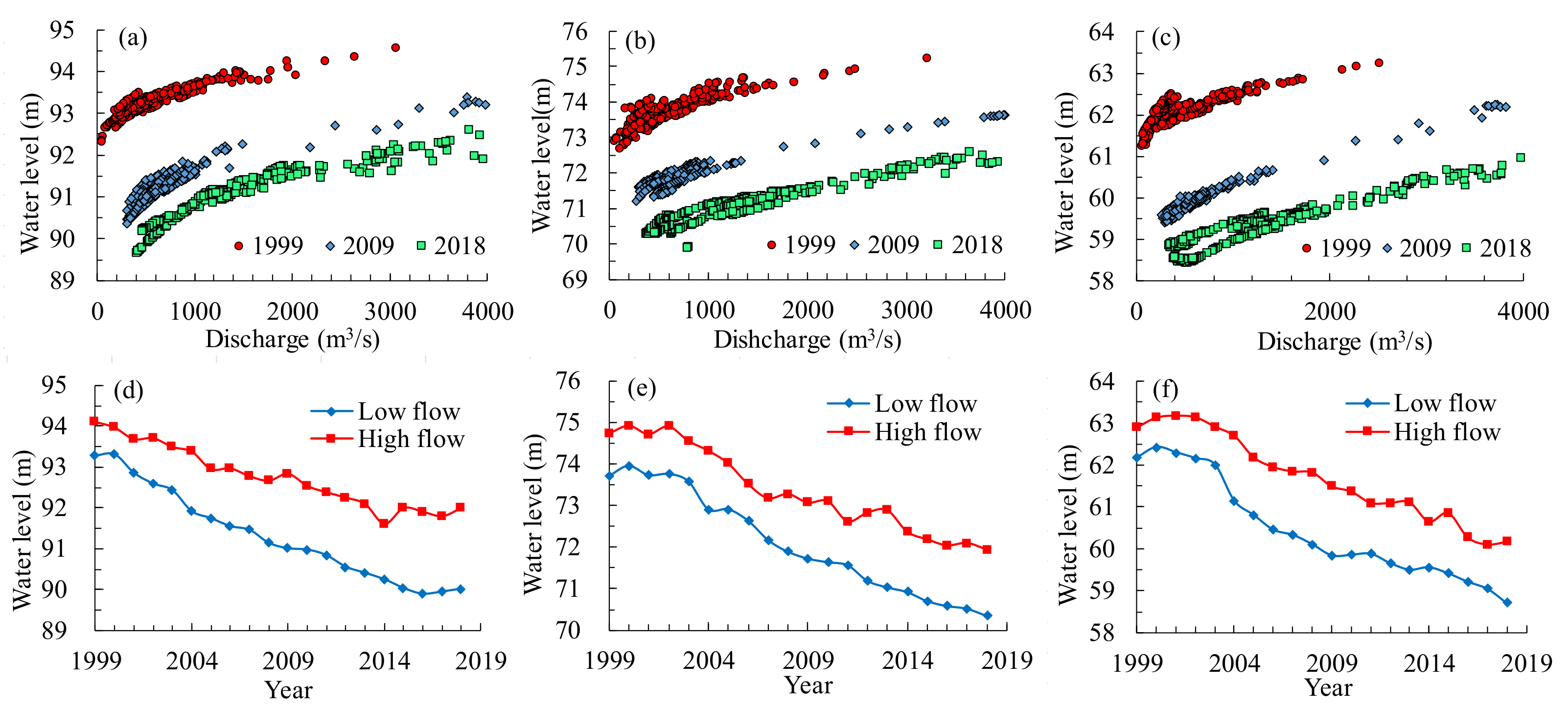Characteristics of Channel Incision Induced by Human Activity in a Wandering Reach in 20 Years
Abstract
:1. Introduction
2. Study Reach and Data Source
2.1. Study Reach
2.2. Data Source
3. Methods
3.1. Calculation of River Bed Downcutting Depth
3.2. Determination of Water Stages at Certain Discharges
4. Results
4.1. Changes in Channel Scour Volume
4.2. Changes in River Bed Downcutting Depth at the Section- and Reach-Scales
4.3. Changes in Water Stage
5. Discussion
6. Conclusions
Author Contributions
Funding
Institutional Review Board Statement
Informed Consent Statement
Data Availability Statement
Conflicts of Interest
References
- Huang, M.W.; Liao, J.J.; Pan, Y.W.; Cheng, M.-H. Rapid channelization and incision into soft bedrock induced by human activity—Implications from the Bachang River in Taiwan. Eng. Geol. 2014, 177, 10–24. [Google Scholar] [CrossRef]
- Dar, R.A.; Mir, S.A.; Romshoo, S.A. Influence of geomorphic and anthropogenic activities on channel morphology of River Jhelum in Kashmir Valley, NW Himalayas. Quat. Int. 2019, 507, 333–341. [Google Scholar] [CrossRef]
- Lyu, Y.W.; Fagherazzi, S.; Tan, G.M.; Zheng, S.; Feng, Z.; Han, S.; Shu, C. Hydrodynamic and geomorphic adjustments of channel bars in the Yichang-Chenglingji Reach of the Middle Yangtze River in response to the Three Gorges Dam operation. CATENA 2020, 193, 104628. [Google Scholar] [CrossRef]
- Brenna, A.; Surian, N.; Mao, L. Alteration of gravel-bed river morphod-ynamics in response to multiple anthropogenic disturbances: Insights from the sediment-starved Parma River (northern Italy). Geomorphology 2021, 389, 107845. [Google Scholar] [CrossRef]
- Lou, Y.Y.; Dai, Z.J.; Lu, X.X.; Li, D. Anthropogenic pressures induced hydromorphodynamic changes of riverine islands in the Upper Jingjiang reach along the Changjiang (Yangtze) River. CATENA 2022, 217, 106488. [Google Scholar] [CrossRef]
- Elznicová, J.; Kiss, T.; Sipos, G.; Faměra, M.; Štojdl, J.; Váchová, V.; Grygar, T.M. A central European alluvial river under anthropogenic pressure: The Ohře River, Czechia. CATENA 2021, 201, 105218. [Google Scholar] [CrossRef]
- Simon, A.; Rinaldi, M. Disturbance, stream incision, and channel evolution: The roles of excess transport capacity and boundary materials in controlling channel response. Geomorphology 2006, 79, 361–383. [Google Scholar] [CrossRef]
- Surian, N.; Rinaldi, M. Morphological response to river engineering and management in alluvial channels in Italy. Geomorphology 2003, 50, 307–326. [Google Scholar] [CrossRef]
- Poesen, J.; Nachtergaele, J.; Verstraeten, G.; Valentin, C. Gully erosion and environmental change: Importance and research needs. CATENA 2003, 50, 91–133. [Google Scholar] [CrossRef]
- Lu, X.X.; Zhang, S.R.; Xie, S.P.; Ma, P.K. Rapid channel incision of the lower Pearl River (China) since the 1990s as a consequence of sediment depletion. Hydrol. Earth Syst. Sci. 2007, 11, 1897–1906. [Google Scholar] [CrossRef]
- Shields, F.D.; Lizotte, R.E.; Knight, S.S.; Cooper, C.M.; Wilcox, D. The stream channel incision syndrome and water quality. Ecol. Eng. 2010, 36, 78–90. [Google Scholar] [CrossRef]
- Wyżga, B.; Zawiejsk, J.; Pawlikc, R.A. Impact of channel incision on the hydraulics of flood flows: Examples from Polish Carpathian rivers. Geomorphology 2016, 272, 10–20. [Google Scholar] [CrossRef]
- Kondolf, G.M.; Swanson, M.L. Channel adjustments to reservoir construction and gravel extraction along Stony Creek, California. Environ. Geol. 1993, 21, 256–269. [Google Scholar] [CrossRef]
- Brandt, S.A. Classification of geomorphological effects downstream of dams. CATENA 2000, 40, 375–401. [Google Scholar] [CrossRef]
- Grant, G.E. The geomorphic response of gravel-bed rivers to dams: Perspectives and prospects. In Gravel-Bed Rivers: Processes Tools Environments; Church, M., Pascale, M.B., Roy, A.G., Eds.; John Wiley & Sons Ltd.: Hoboken, NJ, USA, 2012; pp. 165–181. [Google Scholar]
- Bravard, J.P.; Kondolf, G.M.; Piégay, H. Environmental and societal effects of channel incision and remedial strategies. In Incised River Channels; Darby, S.E., Simon, A., Eds.; Wiley: New York, NY, USA, 1999; pp. 303–341. [Google Scholar]
- Phillips, J.D.; Slattery, M.C.; Musselman, Z.A. Channel adjustments of the lower Trinity River, Texas, downstream of Livingston Dam. Earth Surf. Process. Landf. 2005, 30, 1419–1439. [Google Scholar] [CrossRef]
- Smith, N.D.; Morozova, G.S.; Arlucea, M.P.; Gibling, M.R. Dam-induced and natural channel changes in the Saskatchewan River below the E.B. Campbell Dam, Canada. Geomorphology 2016, 269, 186–202. [Google Scholar] [CrossRef] [Green Version]
- Lai, X.; Yin, D.; Finlayson, B.L.; Wei, T.; Li, M.; Yuan, W.; Yang, S.; Dai, Z.; Gao, S.; Chen, Z. Will river erosion below the Three Gorges Dam stop in the middle Yangtze? J. Hydrol. 2017, 554, 24–31. [Google Scholar] [CrossRef]
- Zheng, S.W.; Xu, Y.J.; Cheng, H.Q.; Wang, B.; Xu, W.; Wu, S. Riverbed erosion of the final 565 kilometers of the Yangtze River (Changjiang) following construction of the Three Gorges Dam. Sci. Rep. 2018, 8, 11917. [Google Scholar] [CrossRef]
- Rinaldi, M.; Wyżga, B.; Surian, N. Sediment mining in alluvial channels: Physical effects and management perspectives. River Res. Appl. 2005, 21, 805–828. [Google Scholar] [CrossRef] [Green Version]
- Kheir, R.B.; Wilson, J.; Deng, Y.X. Use of terrain variables for mapping gully erosion susceptibility in Lebanon. Earth Surf. Process. Landf. 2007, 32, 1770–1782. [Google Scholar] [CrossRef]
- Shit, P.K.; Paira, R.; Bhunia, G.; Maiti, R. Modeling of potential gully erosion hazard using geo-spatial technology at Garbheta block, West Bengal in India. Modeling Earth Syst. Environ. 2015, 1, 2. [Google Scholar] [CrossRef]
- Walker, S.J.; Wilkinson, S.N.; van Dijk, A.I.J.M.; Hairsine, P.B. A multi-resolution method to map and identify locations of future gully and channel incision. Geomorphology 2020, 358, 107115. [Google Scholar] [CrossRef]
- Chu, Z.X. The dramatic changes and anthropogenic causes of erosion and deposition in the lower Yellow (Huanghe) River since 1952. Geomorphology 2014, 216, 171–179. [Google Scholar] [CrossRef]
- Kong, D.; Latrubesse, E.M.; Miao, C.; Zhou, R. Morphological response of the Lower Yellow River to the operation of Xiaolangdi Dam, China. Geomorphology 2020, 35, 106931. [Google Scholar] [CrossRef]
- Lu, M.W.; Zhao, Q.H.; Ding, S.Y.; Wang, S.; Hong, Z.; Jing, Y.; Wang, A. Hydro-geomorphological characteristics in response to the water-sediment regulation scheme of the Xiaolangdi Dam in the lower Yellow River. J. Clean. Prod. 2022, 335, 130324. [Google Scholar] [CrossRef]
- Liu, W.; Wang, S.J.; Sang, Y.F.; Ran, L.; Ma, Y. Effects of large upstream reservoir operations on cross-sectional changes in the channel of the lower Yellow River reach. Geomorphology 2021, 387, 107768. [Google Scholar] [CrossRef]
- Miao, C.Y.; Kong, D.X.; Wu, J.W.; Duan, Q. Functional degradation of the water-sediment regulation scheme in the lower Yellow River: Spatial and temporal analyses. Sci. Total Environ. 2016, 551–552, 16–22. [Google Scholar] [CrossRef] [PubMed]
- Wu, N.; Liu, S.M.; Zhang, G.L.; Zhang, H.M. Anthropogenic impacts on nutrient variability in the lower Yellow River. Sci. Total Environ. 2021, 755, 142488. [Google Scholar] [CrossRef] [PubMed]
- Wang, H.; Yang, Z.; Saito, Y.; Liu, J.P.; Sun, X.; Wang, Y. Stepwise decreases of the Huanghe (Yellow River) sediment load (1950-2005): Impacts of climate change and human activities. Glob. Planet. Chang. 2007, 57, 331–354. [Google Scholar] [CrossRef]
- Xia, J.Q.; Li, X.J.; Li, T.; Zhang, X.; Zong, Q. Response of reach-scale bankfull channel geometry in the Lower Yellow River to the altered flow and sediment regime. Geomorphology 2014, 213, 255–265. [Google Scholar] [CrossRef]
- Bi, N.S.; Sun, Z.Q.; Wang, H.J.; Wu, X.; Fan, Y.; Xu, C.; Yang, Z. Response of channel scouring and deposition to the regulation of large reservoirs: A case study of the lower reaches of the Yellow River (Huanghe). J. Hydrol. 2019, 568, 972–984. [Google Scholar] [CrossRef]
- Li, J.; Xia, J.Q.; Zhou, M.R.; Deng, S.; Zhang, X. Variation in reach-scale thalweg-migration intensity in a braided reach of the lower Yellow River in 1986-2015. Earth Surf. Process. Landf. 2017, 42, 1952–1962. [Google Scholar] [CrossRef]
- Wyżga, B. A review on channel incision in the Polish Carpathian rivers during the 20th century. Dev. Earth Surf. Process. 2007, 11, 525–553. [Google Scholar]
- Chua, S.D.X.; Lu, X.X. What can stage curves tell us about water level changes? Case study of the Lower Mekong Basin. CATENA 2022, 216, 106385. [Google Scholar] [CrossRef]
- Julien, P.Y. River Mechanics; Cambridge University Press: Cambridge, UK, 2002. [Google Scholar]
- Xia, J.Q.; Li, J.; Carling, P.A.; Zhou, M.; Zhang, X. Dynamic Adjustments in Bankfull Width of a Braided Reach. Proc. Inst. Civ. Eng.Water Manag. 2019, 172, 207–216. [Google Scholar] [CrossRef]
- Wu, B.S.; Xia, J.Q.; Fu, X.D.; Zhang, Y.; Wang, G. Effect of altered flow regime on bankfull area of the lower Yellow River, China. Earth Surf. Process. Landf. 2008, 33, 1585–1601. [Google Scholar] [CrossRef]
- Wu, B.S.; Zheng, S.; Thorne, C.R. A general framework for using the rate law to simulate morphological response to disturbance in the fluvial system. Prog. Phys. Geogr. 2012, 36, 575–597. [Google Scholar] [CrossRef]








Publisher’s Note: MDPI stays neutral with regard to jurisdictional claims in published maps and institutional affiliations. |
© 2022 by the authors. Licensee MDPI, Basel, Switzerland. This article is an open access article distributed under the terms and conditions of the Creative Commons Attribution (CC BY) license (https://creativecommons.org/licenses/by/4.0/).
Share and Cite
Li, J.; Zhou, Z.; Ji, Q.; Xiao, B. Characteristics of Channel Incision Induced by Human Activity in a Wandering Reach in 20 Years. Appl. Sci. 2022, 12, 11983. https://doi.org/10.3390/app122311983
Li J, Zhou Z, Ji Q, Xiao B. Characteristics of Channel Incision Induced by Human Activity in a Wandering Reach in 20 Years. Applied Sciences. 2022; 12(23):11983. https://doi.org/10.3390/app122311983
Chicago/Turabian StyleLi, Jie, Zhehan Zhou, Qingfeng Ji, and Baokang Xiao. 2022. "Characteristics of Channel Incision Induced by Human Activity in a Wandering Reach in 20 Years" Applied Sciences 12, no. 23: 11983. https://doi.org/10.3390/app122311983



